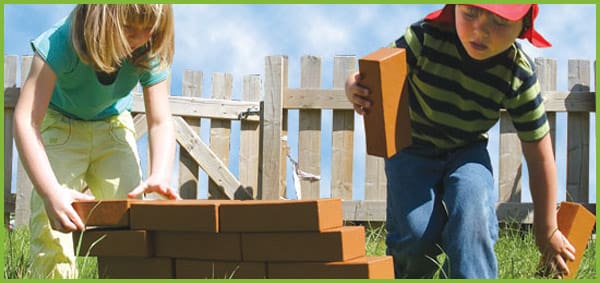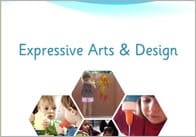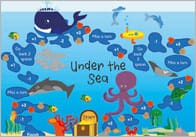Outdoor Play Activities and Ideas (Part 2)

This is the second and final part of my outdoor play article – bringing together tips and ideas to encourage outdoor play. Please feel free to leave comments below or to contact us with further ideas.
– Create dens
Try to set up your outdoor space with open ended play in mind. When it comes to fixed structures where possible you should try and use multipurpose, versatile structures as opposed to structures like ships, trains and rockets which are not easily adapted and can alienate children who do not have an interest in those particular themes. A mixture of wooden posts (with hooks attached), trellis, windfall logs (local councils will often provide large logs free of charge) , willow and bamboo fencing, weaving frames and weaving mesh can be far more effective in encouraging imaginative play especially when used in conjunction with things like temporary hooks, shade netting, camouflage tarpaulin, pretend bricks, old tyres and copper piping. Minsdtretchers has a really great collection of durable and waterproof materials in their den building kit.
To help create a more cosy environment in the dens that your children create you could use an outdoor mat or maybe some outdoor beanbags or bean cubes.
– Build fires and cook on an open fire
Obviously building fires involves an element of risk play, however with the correct equipment and supervision safety need not be a concern. Fire building can form the basis of some really educational, inspirational and exciting early years activities (it can be particularly useful for engaging boys).
Practitioners should take a look at the range of outdoor equipment sold by Mindstretchers. Used in conjunction with their Fire Striker, the mindstretchers Fire bowls are a great way of teaching children about fire in a safe and controlled way. The Fire Striker works in all weather and is a much safer than familiarising children with the process of lighting a match (something they could then repeat should they find a match on the floor etc).
The experience of cooking outdoors can provide a wealth of learning opportunities and can help to give children a real connection with the outdoors. Moreover, it’s an experience that shouldn’t just be reserved for hot summer days. This rather impressive looking BBQ cooking system from Mindstretchers
When it is set up within a proper fire zone it is safe for young children to be near as the outer ring stays cold. The accompanying large bamboo sticks for cooking stickbread are also worth checking out
Remember, staff will require appropriate training to manage fire with children.
– Set up some outdoor habitats
Involve the children in the setting up and maintenance of various habitats. For instance you could set up an ant farm, a wormery, a butterfly garden, a bird house village. If you’re feeling really adventurous you could even try your hand at bee keeping with this bee hive from Insect Lore, specially adapted for use in schools.
As well as setting up habitats for wild animals and minibeasts it’s always a great idea to keep a pet in your early years setting. Guinea pigs are always popular but a really engaging alternative would be to raise and keep ducklings. Obviously you will need some basic facilities to keep either of these and even though they are both relatively low maintenance it will still require a bit of effort. The rewards can be fantastic though as they can really inspire and engage young children and they provide so many learning opportunities.
Where possible you should try and set up a camera in and around the habitats / enclosures so that children can monitor activity. TTS have a number of affordable cameras that could do the job. They stock cameras for specific habitats like the bird box with wireless camera and the pond camera but they also have a generic wireless camera, waterproof snake cope and an incredibly good value live feed camera.
– Early Years Gardening
Whether it’s sowing seeds, planting trees, watering and maintaining flower beds, harvesting food or composting there are so many opportunities for children to have fun and learn in the garden. There’s so much to be said on this subject that I‘ve decided to include it in a separate blog post: Gardening in Early Years Settings.
– Outdoor Water Play Activities
Here are a few ideas taken from a document shared by Jade88 on TES:
Five Little Speckled Frogs:
Sing the song and act it out using the children & frog masks, explain words & use pictures/props to illustrate.
Make a list with the children of the things you will need to create the speckled frogs pool.
Use cement tray or water tray to make a speckled frog habitat for the children to explore and play with. Make mud from potting compost & use grass or art straws to represent reeds. Introduce vocabulary such as pebbles, rocks, mud, reeds, swamp …… and also positional words. Talk to the children about what it would be like to be ‘in the mud’ ‘on the log’ ‘under a rock’ etc.
Paint or make a collage picture of the rhyme. Use cut out frogs or finger puppets or plastic frogs for the children to move around the picture.
Use the picture, water tray habitat or cloth/paper pool & log shapes to play a game. Make a dice or spinner with instructions, e.g. ‘put 2 frogs on the log or 1 frog in the mud ….’
Ten Green Bottles
Sing the song with the children using bottles filled with green water as a prop, hang number labels 1-5 or 1-10 around the necks of the bottles to help with counting. Let the children use the bottles, with funnels, in the water tray to explore filling and emptying and counting. Make patterns of holes in the bottles to make different types of sprays.
Who Sank The Boat?
Make a collection of plastic animals (including a sheep, pig, donkey, mouse, cow ), boats, re-cycled materials to make boats from.
Use a transparent water tray or fish tank and a variety of things to explore floating and sinking with the children. Look at some objects which float e.g. boats or plastic food trays, and add pebbles or other small objects to make them sink. Ask the children to say what will happen. Can they find other ways to sink the boats?
Show children pictures of different types of boats and discuss what they might carry and which could carry the heaviest load.
Read the story to the children and talk about what happened as each animal boarded the boat. Discuss ‘balancing’ Why do they think a tiny mouse sank the boat?
Use the boats/animals to retell the story and explore different combinations of animals. What happens if they fill the boat? Put all the animals on one side or at one end?
Water Channelling
Preparation and planning:
Look at pictures of pipes & guttering being used to direct the flow of water; go for a walk around the setting and look at downpipes, guttering, waste pipes – talk about what they do.
Discuss pipes of different lengths with children. Set up different arrangements which have straight lengths and bends.
Use pipes with open guttering so that the children can see the direction of flow.
Discuss how the equipment is to be used. For example, pipes to be positioned over the water tray, aprons to be worn and how spillages are to be dealt with.
Working in the area and developing activities:
Demonstrate pouring water in the middle of the pipe and ask children to predict where the water will flow to.
Vary length of pipes to demonstrate the different exit points of water flow.
Vary the angle of the pipes – does this affect the speed of water flow?
Introduce a wider variety of descriptive language with words such as pour, drip, dribble, gush,rush, waterfall……..
Encourage children to join pipes so as to move the water from one place to another – and ask questions such as: “what if?” “have you thought of?” “why do you think that happens?” “how might we make the water change direction?”
Encourage the children to use mathematical language: full; half full; empty; up; down; slow; fast; slower; faster.
Encourage the children to work collaboratively to develop their arrangements.
You may also find our article on setting up an outdoor water play area useful. Also, if you missed it you may like to read part 1 of this article.
Comments
Leave a Reply
Popular Teaching Resources
Stay Up To Date
Sign up for our newsletter and we’ll let you know when we create new early years resources.






Hello!
Your readers might be interested in the Learning Outdoors course delivred at CREC (Birmingham) by Jan White. To find out more go to: http://www.crec.co.uk/learning-outdoors-in-early-childhood